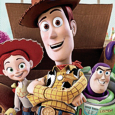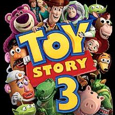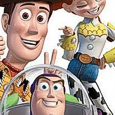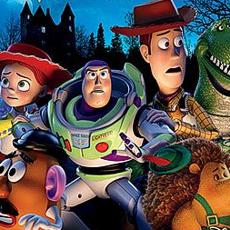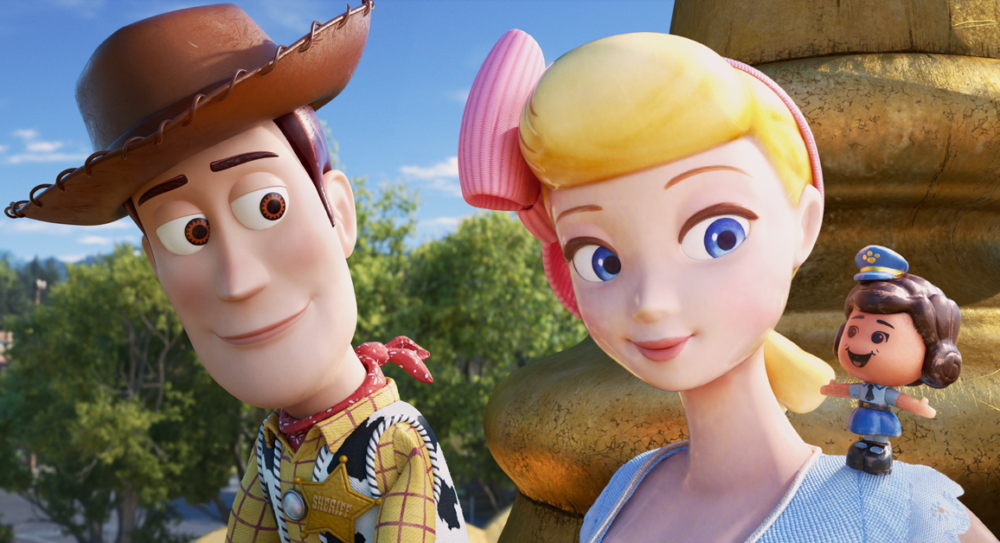Disney/Pixar (June 18 2010), Walt Disney Studios Home Entertainment (November 2 2010), 2 Blu-ray Discs plus single DVD and Digital Copy, 103 mins plus supplements, 1080p high-definition 1.78:1 widescreen , DTS 7.1 and 5.1 Master Audio and Dolby Digital EX, Rated G, Retail: $45.99
Warning: as usual, we’ve tried to avoid spoilers, but some plot points are discussed openly.
Storyboard:
The toys are back in town (again) after leaping out of the toybox and finding themselves at a curiously perfect day-care center, where not everything, or all the welcoming toys, are what or who they seem…
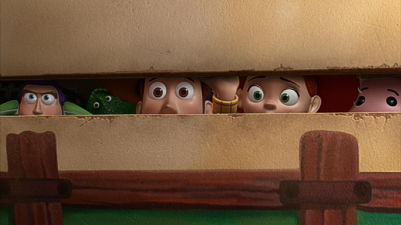
The Sweatbox Review:
I’ve been pretty quiet about my thoughts on Toy Story 3 since its theatrical release earlier this year, because I genuinely wasn’t sure about how I felt about it. And despite the fact that it is hugely entertaining and, at times, emotionally compelling, it’s a film that I just wasn’t sure needed to be made. Now, having waited to see it again on home video, free of the 3D distractions that I have to say didn’t add anything to my original viewing, I urge you, dear reader, to continue on with this review, discover why I still feel the same way and, just maybe, offer an opinion that backs up that reasoning.
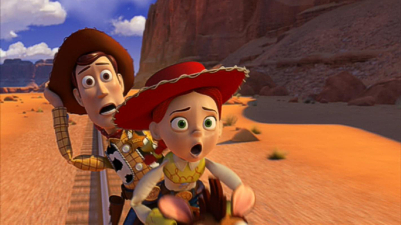
The first Toy Story, coming in 1995 on the wave of Tom Hanks’ rise to the A-list via double Oscar wins for Philadelphia and Forrest Gump as well as the thick end of Disney’s own animation renaissance, proved to be a winning combination of star vocals and precision marketing. Not only that, but the movie itself lived up to the hype, changing the face of animation from hand-drawn musicals to computer-generated comedies practically overnight. Within months, rival studios were in on the game, with the ripple effect still being felt today, some fifteen years after its debut.
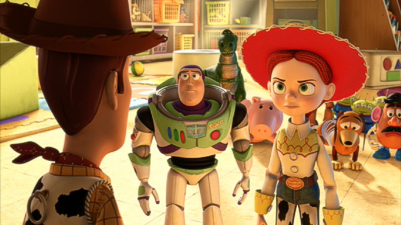
Naturally a sequel was ordered, and managing to overcome a particularly troublesome production, emerged as a genuinely superlative successor, with comparisons made to those other rare sequels that managed to eclipse their precursors, The Godfather Part II and The Empire Strikes Back. Rumors of a third film almost immediately surfaced, but the problem was that Disney wouldn’t accept a sequel project (and one that had started as a direct-to-video quickie) in the terms of their five original picture deal with Pixar, leading to almost ten years of wrangling before an agreement was made for Disney to buy the CG company out.

Part of the bargaining tactics that Disney had put in play was the setting up of the Circle 7 Animation facility, at one time destined to produce sequels to Pixar’s pictures. The thought of the Toy Story characters being involved in nothing more than money-making movies (a plot that had defective Buzz Lightyears being recalled to Japan, only for Woody and the team to head out on a rescue mission) must have played no small part in Pixar’s returning to the negotiating table, after which Circle 7 was shuttered, and that version of Toy Story 3 scrapped. Original series creator and director John Lasseter envisioned a third chapter would end with the characters cared for and being played with by children – after all, that’s what toys are for – and as soon as the ink had dried on the Disney/Pixar contract, that third film was put in the capable hands of part one’s editor and part two’s co-director Lee Unkrich.
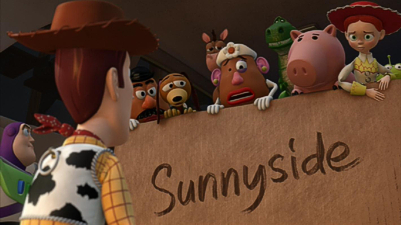
I’m sure he and his story crew quickly found that threequels are notoriously hard things to pull off. There’s the pressure of matching up to a beloved or successful first film as well as not repeating the tricks that had already been played in overcoming the same problems with the difficult second outing. Perhaps its these reasons that third films often return to the core values of the first: you’ll find that many modern trilogies’ third installments essentially play out the first film’s basic plot again as a way to tie up loose ends and round up the essential three-act structure. It’s also why third films tend to not be quite as appreciated as their two predecessors, and for good enough reason: the characters and situations are just not that fresh any more, and much that can be done with them has more than likely already been done.
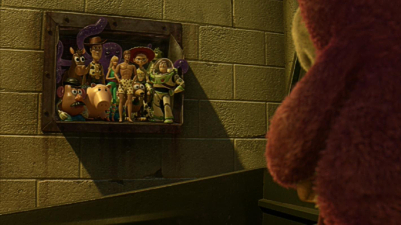
That’s certainly the case for me with Toy Story 3, even if it does do a much better job of rounding things up than some other threequels have managed to do in recent times. But in doing so, it felt to me that we were being treated to the best core elements of the first two films again, as opposed to really expanding the characters and story experience. The return to a single location for much of the film echoes Andy’s room from the first film, while much of the plot’s kidnap and rescue elements re-run the second film with Woody as hero instead of Buzz. That’s all fine, as long as there’s something new to hold it together, but it’s not there in Toy Story 3, being a wonderful collection of moments that too strongly recall better sequences in not only the first two films, but other Pixar pictures too.
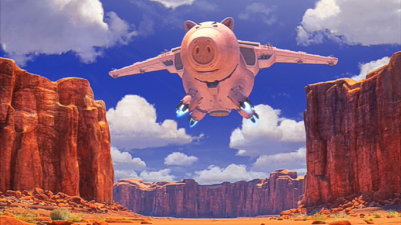
It opens with a typically “real” adventure sequence, now a Toy Story trademark after Woody’s western shootout from the first film, and Buzz’s intergalactic mission of the second. So, with both principal characters already having taken center screen for each respective film’s opening, what’s the solution here? Why, just like the Terminator (first he was bad, then he was good, then he was bad and good!), we get a dual setting opening, combining Woody’s west with Buzz’s superheroics and a surprise alien attack. It’s good, exhilarating stuff, but we’ve seen similar before, at the end of the second film, which very cleverly spoofed the western movie shots of John Ford and the like, and many of the same are basically repeated here straight in, including music cues from that previous sequence. More still, there’s a hyper sensitivity that feels a little too manic, as if they know they’re repeating themselves but feel if they make it bigger, faster, funnier, no-one will really notice.

It’s just that, for me, that second film nailed it so completely: the last lines referring to what would happen when Woody and Buzz’s owner Andy grew up and didn’t need them anymore. “I’ll enjoy it while it lasts”, says Woody, before Wheezy the penguin swings into a terrific Vegas take on the series’ signature tune You’ve Got A Friend In Me. The ending closed the film on a perfect note, remaining upbeat, hugely enjoyable and leaving the audience with a wide grin on their faces. It was also a definite close to the adventures of Woody and Buzz, the last word on what could be done with the characters and that particular story.
From when Pixar’s Toy Story 3 was announced, I was intrigued as to how they could “re-open” that toy box without it feeling strained, and I was sceptical even heading into the theater to see the film. The western/spaceship opening didn’t do much to allay my fears, but the following scenes managed to change my mind: seeing Andy growing up via the miracle of home movie videotape, I suddenly “got” it…Woody was going to enjoy it while it lasted, and now we were going to see what would happen when it ended, playing out onscreen. Okay, I thought, I buy it, I’m in…now let’s see where we go from here.
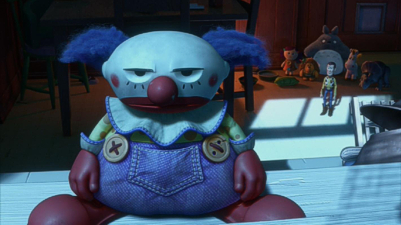
If there’s one thing that can be said for the film in terms of moviemaking bravery, it’s that Toy Story 3 is, at times, amazingly depressive. The downbeat tone begins almost immediately, with Woody lamenting the fact that Andy doesn’t play with the old gang anymore, and the toys they’ve lost along the way. This is Pixar doing what it does best, slipping in a wonderfully subtle tribute to Joe Ranft, among what amounts to be a mind-screw: the toys are mindful of their “immortality”, with Woody and Buzz acting like the grown up parents to the rest of the gang. It’s pretty heady stuff for what is ostensibly a “children’s film”, and remarkably reflective of the filmmakers’ new status as mature adults and parents themselves – this isn’t the Toy Story 3 that the team would have made ten or maybe even five years ago.

Unfortunately, just as fast as I’d finally tuned in, my interest began to waver again, once the toys have been shipped off to the Sunnyside day-care center and the film comes to something of a halt. It doesn’t help that new lovable day-care character Lotso, the supposedly huggable bear, is clearly not to be trusted, and therefore becomes a retread of Prospector Pete from the second film, while Pixar lets itself down by resorting to an overly pop-culture reference when Barbie meets the day-care’s Ken doll for the first time. Pixar hasn’t been immune from such references, of course, and I’m not suggesting that they should be, but how many times has a character’s eyes met another’s and everything stops for a slo-mo moment accompanied by a typical love ballad swamping out the soundtrack (in this case Gary Wright’s DreamWeaver, though proving how interchangeable these things are, it was Berlin’s Take My Breath Away in the trailers)? It’s not that it’s a taboo pop-culture reference in a Pixar film, it’s that it’s such an old and overused gag, funny for a second, but again nothing new and not playing to the usual Pixar standard. And then they do it again, with Chic’s Le Freak playing over a Ken clothing montage…funny, but not a consistent or authentic part of the Toy Story universe.

The rest of the film continues to run along re-running themes from the first two films: Woody is disassociated from the rest of the group, Jesse has abandonment issues (actually, quite annoyingly), and Lotso’s backstory echoes the similar treatment of Jesse’s. Even Buzz makes another transition, though having done the practical switches with the character previously, a dubious as yet undiscovered “feature” of the Lightyear action figure sees him reset first as a Space Ranger and then later as an Spanish-speaking lothario…again funny while it’s happening, and probably hysterical when it came up in the story meetings, but just not true to the character, again feeling like a last resort after jokes about Buzz being a deluded spaceman were played out in the first two films (an end credit extension of this joke, a Spanish version of You’ve Got A Friend In Me, again seems like a desperate play to do something “different”, if not actually original or clever, with the series’ stock trademarks, almost as if Pixar is selling out their characters for cheap laughs).
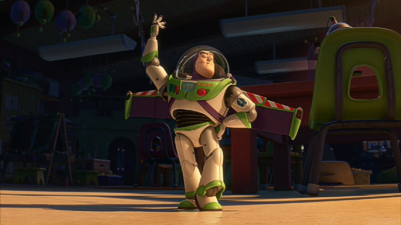
And that, ultimately, is the real predicament over Toy Story 3. It’s all perfectly well made, amusing in spots, tremendously layered and often surprising in how downbeat it is, but none of it feels particularly fresh, and the plotting gets bogged down in Sunnyside for far too long, playing backwards and forwards with the characters wanting to stay at the day-care, then leave, then forced to stay, trying to escape, etc, meaning the film circles around a while and doesn’t really venture anywhere new for large chunks of it. The middle is especially slow moving, repeating some same visual or plot information in two or more scenes, usually a Pixar no-no, until Woody returns to break the other toys out.
Of course, this being a Pixar movie, it’s not all a long slog, and there are moments that remind us that we’re watching a film from the best purveyors of family entertainment: Michael Keaton’s debut as Ken is brilliant, both from his vocal delivery and the deliciously teeny details in his animation…an excellent addition to the gang and one of the film’s best elements. And then there are the thousands of other little touches, and animation that continues to build on the previous films that reaches an exceptional level. The scary, cymbal-wielding monkey toy is also fantastically frightening, and a few times I was surprised that the film got away with a G-rating: if it’s not only pretty terrifying for younger children in parts, the mature themes and overall melancholic feel will surely need some parental warmth to help them through some of the tougher moments.

These include the double ending, which finds Lotso and his henchman Big Baby playing out Darth Vader’s defeating of the Emperor scene from Return Of The Jedi, before the film ends up running down that other old Pixar staple, the conveyor belt, used at the end of the second film, but here with the added emotional depth that the toys really have made their last moves. In a spot of purely visual storytelling, the characters face their doom not by shrieking or trying to save themselves, but by holding hands, and it’s a great moment that finally brings the characters together in a way much of the film has struggled to do. Of course, there’s never any doubt that Wood, Buzz and company will be reprieved at the eleventh hour (a little too conveniently, as it happens), but a late return for Lotso, who has apparently changed his ways, is also predictable and doesn’t ring true (I won’t be a totally killjoy and say that, minutes before the toys are trashed into the fiery furnace, they would have melted to mush anyway from the heat).

However, all that aside, this penultimate sequence is what pulls the film together, right at the last moment, leading to the film’s payoff, which does build on the ending of the second film: realizing that he’s really too grown up to keep his old stuff, Andy donates them to the day-care owner’s daughter, having one last play with them as he hands them over. The teenaged girls sitting behind me in the theater were either too young to full embrace the sentiments in the moment, or were self-conscious about the scene, but it struck me as being very true and personal, and a wonderfully subtle way to give the characters their final curtain bow, as it were (although quite why they didn’t choose to return to a Sunnyside where Lotso’s dictatorship has been wiped out isn’t clear, leaving the path open for a potential fourth adventure).
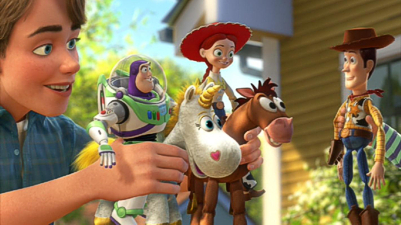
Ultimately, even if Toy Story 3 isn’t always successful as a piece of fresh moviemaking, it does hold up as a solid family feature film, though only just as a worthy addition to the otherwise untouchable first two films. In many ways, with the film coming in the franchise’s 15th anniversary – and therefore a landmark for Pixar themselves too – it’s as if the company has gone full circle in their feature length endeavors, coming back to the series that really started them off on a path to where several of their young names have “grown up” and are starting to venture out on their own and into the real world via major live-action projects.

So it’s nice that Woody, Buzz and all the characters get a final hurrah before the nature of Pixar potentially shifts: Toy Story 3 marks the end of an era for the Studio, and a fitting one at that, even if third time out doesn’t capture the spark or real magic of before, whatever the complex emotions and serious nature of the mature themes strive to do. Because, for all that heavy attitude, I just can’t shake the feeling that the basic Woody rescues Buzz plot might have provided more scope and authentic Toy Story fun if it had played out as an international mission to Japan. But, then again, there’s always Cars 2 revving up to drive away with that idea…!
Is This Thing Loaded?
With two Blu-ray Discs awarded to the feature presentation and its supplements, you’d be expecting a good few hours of immersive bonus content, and this Toy Story 3 set absolutely delivers in the way of the packed Pixar DVD collectors’ editions of the past. Unlike the Studio’s Up, which felt strangely, slightly subdued, there is a lot of material here, and despite that we’re going around for the third time in this series, it all feels rather fresh again even if it doesn’t quite surprise with any rare footage or insights that the greatest special editions manage to locate. That said, there’s a terrific amount to see over the two BDs, the single-disc DVD, and the bundled in Digital Copy that comes in this flagship four-disc collection.
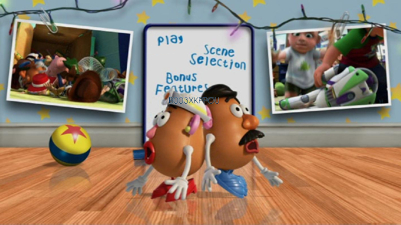
Disney has always loved its Sneak Peeks and the first BD is no exception, running a hysterical spot for BD-3D, which I’m not sure I like the look of if it’s going to bring real snow in to, and blow up, my home theater, Disney’s Tangled, Santa Paws (with the voice of Morgan Freeman!?), Bambi, the Cars 2 teaser and several more from the optional menu. The main menu itself if worth left running for a couple of minutes, as Mr and Mrs Potato Head fumble around waiting for the viewer to make a selection, and there’s one of Disney’s customary Screen Saver options to save the menu burning in on your display, and there are a generous 34 chapter stops for the feature presentation.
Featured with Toy Story 3 in its theatrical run, Teddy Newton’s absolutely wonderful animated short Day & Night is also included on the first disc, depicting what happens when two opposing characters clash and discover they have more in common than they first think. With some terrifically whimsical and witty gags (the waterfall makes me laugh out loud every time), the short is another gem in Pixar’s collection of such films, the only disappointment here being that it doesn’t come accompanied with a commentary, in the way previous Pixar shorts have done occasionally in the past, though some background is provided elsewhere in the set.
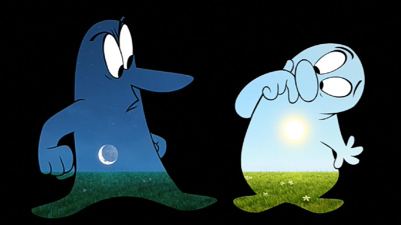
Somewhat unfairly overshadowing Day & Night on the main menu is the “recommended bonus feature” Buzz Lightyear Mission Logs: The Science Of Adventure, episode three in the series that began on the Toy Story and Toy Story 2 Blu-rays from earlier this year. It’s interesting, but tenuously linked to the character by having a plastic figure Buzz floating through the International Space Station via NASA footage. Directly linked, with a fun peek into production, the six-minute Toys! featurette speaks to production designer Bob Pauley about the numerous toys, new and old, that appear in the film, as well as how the classic characters were re-rigged from the ground up to take advantage of improvements in CG techniques since the first film’s debut.
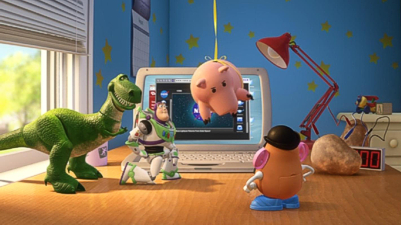
On to Disc Two, where the majority of the bonus features are to be found, though it may be simpler to bypass the many different configurations (a grouping of extras for family viewing, for film fans, based on wanting to play the disc’s game, heading right for the publicity section) to head for the FastPlay options that customizes your viewing experience anywhere from the full list of supplements, to squeezing things down to a two-hour, half-hour or ten minute runtime. The FastPlay option is the best way to see everything, though it’s frustrating that individual sections can’t be accessed from this menu, since the Family and Film Fans selections don’t include everything.
First up is the feature-length Cine-Explore visual commentary track with director Unkrich and producer Darla K. Anderson – yes, that’s not a typo that the entire movie is repeated, at pretty much the same bitrate as on the first disc, again for some reason, and I wonder if Disc One was at some point due to also contain a 3D edition of the film, since the configuration is completely confusing as surely the picture-in-picture aspects could be switched off to let the movie play as it does on the first disc anyway? With the same audio options available, I’m more than a little lost as to why the film has been included twice!

Nonetheless, Unkrich and Anderson’s commentary is a good one, even if recorded before the production was even complete it lacks the perspective that a retrospective track usually provides. But there’s something to say for a discussion that comes right at the tail end of making the actual movie and, as such, their remarks are rife with the right-here, right-now battle scars of creation. The comments also confirm some of my own thoughts about what works in the film, and what I didn’t feel was fully nailed, with the reasons provided often making sense in my reactions to the finished product, which added a layer of interest for me, and the visual additions pack in absolutely everything from concept art, alternate concepts, storyboards, design, pre-viz, animation tests, stills, footage…the list goes on. More than anything, the reasons why Pixar are Pixar are again revealed in the sheer amount of thought that obviously goes into each and every nuance, and does that great thing that the best commentaries do in providing a re-appreciation for the final result.
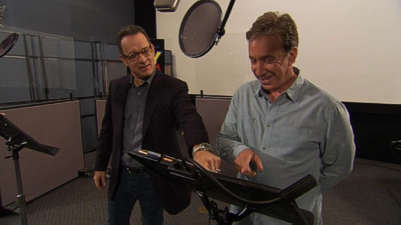
Moving on, and the sheer wealth of production featurette supplements means you’ll need a long evening put aside to fully enjoy them all – and they’re all worth exploring, covering practically all areas. The Gang’s All Here (10:24) reunites the voice cast and introduces the new characters, including a returning – and amusing – Don Rickles, and touching on the continuation of Slinky Dog after Jim Varney’s untimely passing on, while next is a look at the film’s first and final sequences broken down into behind the scenes chunks. Roundin’ Up A Western Opening (5:42) develops the original alternate “Showdown” opening to what was seen in the final film, while Goodbye Andy (8:02) naturally explains the farewell moments between the now young man and his passing on his beloved toys to an enthusiastic new owner.
Accidental Toymakers (3:56) looks at the remarkable “reverse engineered” trip from screen to store shelf for the filmmakers as they become, as Unkrich says, “toy designers” following the success of the first film and the creations of new personalities for Toy Story 3. Screenwriter Michael Arndt discusses his craft in Beginnings: Setting A Story In Motion (8:13), covering Pixar’s story development process and how the Little Miss Sunshine scribe plugged into that culture, although the over-analysing the Studio’s previous pictures actually seems to dumb them down and formularize them a bit. More interesting is Bonnie’s Playtime: Story Roundtable (6:26), which properly dissects this moment, post-making, with Unkrich and his crew returning to how the apparently troublesome sequence was finally shaped.
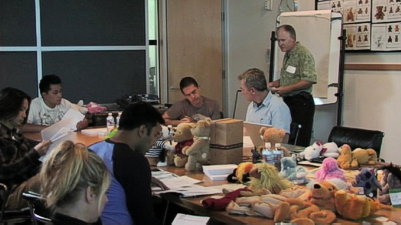
Delving further into that process, the Life Of A Shot (6:57) initially promises to explore the various elements to be found in just one single set-up of the film, on screen for a scant few seconds, but instead it reverts to documenting the props, styling and designs of the opening sequence, drawing attention to aspects to most audiences would probably take for granted. Somewhat randomly thrown into the proceedings, the two-minute Making Of Day & Night gathers the production crew, including director Newton, to reminisce about the creation of the short, and although it’s nice to have something to place the short in context, it’s a shame that they only relate how hard it is to accurately describe the short as opposed to how they managed to pull the very tricky melding of traditional and computer animation off, the final end card revealing it to be little more than promotional fluff advertising the short “in theaters with Toy Story 3 June 18”.
Simple but effective for a bolt-on inclusion, the Toy Story Trivia Dash game offers two players the chance to test their knowledge either on the entire trilogy or just the third instalment as either Woody or Buzz, and since it doesn’t try to be overly showy or clever, it remains enjoyable over its four levels, the entering the players’ secret scores in the final heat a good use of Blu-ray’s added interactivity. We’re back to the featurettes for A Toy’s Eye View: Creating A New Land (5:19), though this is more a look at the spin-offs from the movies, specifically how the characters were adapted for the Disney theme parks, by way of Buzz Lightyear’s Astro Blasters and Toy Story Mania attractions, to the development of the new Toy Story Land, though the logistical talk means this is a proper peek into the construction and not just a fluffy promo piece.

As if Unkrich and Anderson’s feature-length comments weren’t enough, a completely technical observation can be found in the Beyond The Toybox alternate commentary track that gathers members of the animation crew. Here, a lot of informative technological talk peppers the discussion, and geeks will be delighted with the detailed exploration of light, color, textures and simulations, as well as how certain shots were achieved, but it’s otherwise a fairly dry track that general viewers will probably, and understandably, want to give a miss and without any picture-in-picture embellishments, I’m again perplexed why the movie has essentially been included twice in this set, but there must have been some valid reason.
Various promotional spots feature next, from a four-minute Grab Bag that pulls together various promotional spots that anticipated the premiering of the movie, from Mrs Potato Head talking loudly in a theater, to various plus for the 3D experience, and three of Ken’s Dating Tips (1:30), to the brilliantly executed Lots-O’-Huggin’ Bear Commercial (:30) and Lots-O’-Huggin’ Bear Japanese Commercial (:30) that both run like a lost pieces of footage thankfully saved for posterity from the early 1980s via a crummy old VHS recording. A joke Making Of The Lots-O’-Huggin’ Bear Commercials (1:28) shows some raw footage from the live-action shoot, though it would have been cool to have a serious discussion on this process even if it’s interesting to note the “Happy Bear” marker on the clapperboard; a neat way for Pixar to keep the character name a secret until it was ready to reveal his true identity.
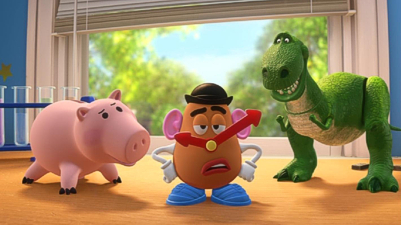
The Publicity offerings continue with a series of promo spots: an Internet Chat (1:00) between Woody and Buzz, the scary movie trailer-like Security Cam teaser (1:12), and the high-tech Gadgets (:54), while Dancing With The Stars At Pixar (2:20) shows how the choreographers of the hit show assisted with Spanish Buzz’ Latino-hot dance moves. A TS3 Silence Trailer (:40) repeats the Potato Heads’ movie theater disruption, and the TS3 Antipiracy Trailer (:56) does what it says on the tin, while a welcome inclusion, after so many titles left them off their respective discs, are a number of Theatrical Trailers for the film, offering up the Teaser (1.40), Trailer #2 (2:20), Trailer #3 (2:25), and Japanese Teaser #1 and Trailer #2 (3:46 combined), with some Character Intro (2:00) interstitials and a 25-image Poster Gallery thrown in (though the lack of any other developmental galleries is greatly lacking).
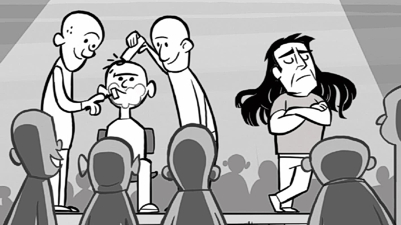
Continuing the Paths To Pixar mini-documentaries begun on the Toy Story and Toy Story 2 discs, Editorial (4:38) shines Luxo’s lamp on Pixar’s picture cutters, while three semi-animated Studio Stories asks Where’s Gordon? (2:16), visits the Studio’s Cereal Bar (1:26) and reveals the hairy business behind the making of the movie in Clean Start (3:05). Finally, instead of the principal cast and crew come together again to reflect on the production experiences of making Toy Story 3, the disc’s Epilogue (4:23) is actually a full-frame rendering of the closing credits moment of the film, now viewable up close.

As for rest of the pack, the standard definition DVD supplements are limited to the Sneak Peeks (Blu-ray promo, Tangled, Santa Paws, Bambi, Cars 2 and more from the menu options), the Day & Night short, Unkrich and Anderson’s feature-length audio commentary, Buzz’s Mission Log, Paths To Pixar: Editorial, the three Studio Stories, and the Toys!, The Gang’s All Here! and Toy Story Land featurettes – obviously not as in-depth as the BD but not exactly skimping either – and the bundled in Digital Copy offers a portable file copy of the movie for playing in your choice of format.
As in-depth as the bonus features are on the BDs, their access isn’t always as simply set out or grouped together as usual from the menus, there’s a reliance on pre-release promotional clips, and Pixar’s customary inclusion of production concept and development art is a noticeable omission, now mostly covered in the Cine-Explore feature, but not available for closer inspection despite the space on the first disc. Nevertheless, there are a good few hours of features to wade through here and, third time around, there isn’t really the need to repeat any basic information we have probably learned from previous releases.
Case Study:
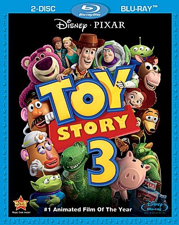 Available in a multitude of configurations, fans that collected the first two Toy Story movies on Blu-ray will lament the fact that this four-disc “all-in” pack doesn’t really continue the design style of those releases. It’s a thick case presentation, needed to house all the discs, and the artwork uses one of the theatrical posters instead of a character portrait, although there is a lower-cost BD-only edition that features a character-focused design [pictured right] that’s much more in keeping with the first two films (and comes slimline, so they’ll match up nicely). However, that throws out the DVD and Digital Copy discs, so you’ll need to think if those matter to you.
Available in a multitude of configurations, fans that collected the first two Toy Story movies on Blu-ray will lament the fact that this four-disc “all-in” pack doesn’t really continue the design style of those releases. It’s a thick case presentation, needed to house all the discs, and the artwork uses one of the theatrical posters instead of a character portrait, although there is a lower-cost BD-only edition that features a character-focused design [pictured right] that’s much more in keeping with the first two films (and comes slimline, so they’ll match up nicely). However, that throws out the DVD and Digital Copy discs, so you’ll need to think if those matter to you.
If you haven’t picked up any of the Toy Story films on Blu-ray yet, you may be enticed to look at the Trilogy Ultimate Toy Box, which packs in the BDs for each feature and supplements, DVD copies for the three films, as well as previously unreleased Digital Copy discs for the first two movies in addition to part three, of course, to make up a 10-disc set, which sounds pretty amazing until you realize that only the four BDs are the only things of real value, and the (quite pricey) covered wagon packaging isn’t the most attractive or practical for storing them. Inside most packs, you’ll find various promos touting Blu-ray, Blu-ray 3D and multiple upcoming titles, including the HD debut for The Incredibles next spring!
Ink And Paint:
It’s becoming harder and harder to keep coming up with ways to describe how perfect a digitally produced image can look on Blu-ray, so it should suffice to say that no-one should find anything to complain about with Toy Story 3’s presentation, especially since the movie has the entire first disc to itself. Although it was presented in 3D in theaters, no such edition has been forthcoming (yet), which is all for the good in my books, until the technology companies figure out a way to make such viewing specs-free. This leaves the supplements to rest on Disc Two, along with the movie’s Cine-Explore feature, and even here things still look great. The DVD does what it can as well, providing a naturally softer image without the high resolution of HD, but looking rock solid and uncompressed, with only the smattering of limited extras to draw any bits away from the movie.
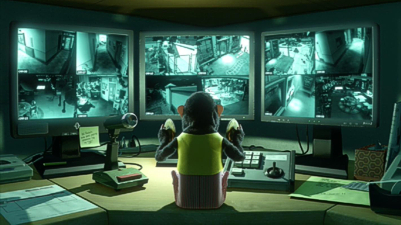
Scratch Tracks:
Like picture, like sound: with the whole first disc handed over to the movie in HD and a full DTS-MA 7.1 soundtrack, the film easily makes for top-line demo material, even if there aren’t really any stand-out “big” sequences that would provide the content for such a demo. It’s available in several flavors, including DTS 5.1, and the sound on the DVD is also more than serviceable (in the quick checks I made), with additional dubs and subs available (in various languages and formats across both discs) covering English, French and Spanish Dolby Digital EX among others.
Final Cut:
Perfectly made, highly entertaining and massively commercial films don’t always make for all-time classics, and for me Toy Story 3 simply struggled to bring anything new to the franchise that was so perfectly capped previously at the end of the second film. It’s fine entertainment to be sure, but the freshness is missing, repetition certainly creeping in, and a (very) slight air of desperation in where to take the characters means that, although it’s an enjoyable movie, I can’t see it being repeated viewing more than the first two films, once the novelty wears off. Although this set presents the film with the required and adequate amount of extras, Disney and Pixar, despite the huge box-office numbers, would do well not to cave into temptation to try and make another: it must be said that the toy box has been well and truly raided now.
 | ||
 |


